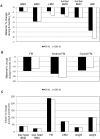Impact of vitamin D supplementation during lactation on vitamin D status and body composition of mother-infant pairs: a MAVID randomized controlled trial
- PMID: 25232839
- PMCID: PMC4169453
- DOI: 10.1371/journal.pone.0107708
Impact of vitamin D supplementation during lactation on vitamin D status and body composition of mother-infant pairs: a MAVID randomized controlled trial
Abstract
Objective: The optimal vitamin D intake for nursing women is controversial. Deterioration, at least in bone mass, is reported during lactation. This study evaluated whether vitamin D supplementation during lactation enhances the maternal and infant's vitamin D status, bone mass and body composition.
Design and methods: After term delivery, 174 healthy mothers were randomized to receive 1200 IU/d (800 IU/d+400 IU/d from multivitamins) or 400 IU/d (placebo+400 IU/d from multivitamins) of cholecalciferol for 6 months while breastfeeding. All infants received 400 IU/d of cholecalciferol. Serum 25-hydroxyvitamin D [25(OH)D], iPTH, calcium, urinary calcium, and densitometry were performed in mother-offspring pairs after delivery, and at 3 and 6 months later.
Results: A total of 137 (79%) (n = 70; 1200 IU/d, n = 67; 400 IU/d) completed the study. 25(OH)D was similar in both groups at baseline (13.7 ng/ml vs. 16.1 ng/ml; P = 0.09) and at 3 months (25.7 ng/ml vs. 24.5 ng/ml; P = 0.09), but appeared higher in the 1200 IU/d group at 6 months of supplementation (25.6 ng/ml vs. 23.1 ng/ml; P = 0.009). The prevalence of 25(OH)D <20 ng/ml was comparable between groups at baseline (71% vs. 64%, P = 0.36) but lower in the 1200 IU/d group after 3 months (9% vs. 25%, P = 0.009) and 6 months (14% vs. 30%, P = 0.03). Maternal and infants' iPTH, calciuria, bone mass and body composition as well as infants' 25(OH)D levels were not significantly different between groups during the study. Significant negative correlations were noted between maternal 25(OH)D and fat mass (R = -0.49, P = 0.00001), android fat mass (R = -0.53, P = 0.00001), and gynoid fat mass (R = -0.43, P = 0.00001) after 6 months of supplementation.
Conclusions: Vitamin D supplementation at a dose of 400 IU/d was not sufficient to maintain 25(OH)D >20 ng/ml in nursing women, while 1200 IU/d appeared more effective, but had no effect on breastfed offspring vitamin D status, or changes in the bone mass and the body composition observed in both during breastfeeding.
Trial registration: ClinicalTrials.gov NCT01506557.
Conflict of interest statement
Figures




References
-
- Pludowski P, Holick MF, Pilz S, Wagner CL, Hollis BW, et al. (2013) Vitamin D effects on musculoskeletal health, immunity, autoimmunity, cardiovascular disease, cancer, fertility, pregnancy, dementia and mortality-a review of recent evidence. Autoimmun Rev 12: 976–989. - PubMed
-
- Specker BL, Tsang RC, Ho ML (1991) Changes in calcium homeostasis over the first year postpartum: effect of lactation and weaning. Obstet Gynecol 78: 56–62. - PubMed
-
- Milman N, Hvas AM, Bergholt T (2011) Vitamin D status during normal pregnancy and postpartum. A longitudinal study in 141 Danish women. J Perinat Med 40: 57–61. - PubMed
-
- Narchi H, Kochiyil J, Zayed R, Abdulrazzak W, Agarwal M (2010) Maternal vitamin D status throughout and after pregnancy. J Obstet Gynaecol 30: 137–142. - PubMed
-
- Wawrzyniak A, Hamulka J, Gorzel K (2009) [Assessment of vitamins and minerals intake with supplements during breast-feeding]. Rocz Panstw Zakl Hig 60: 353–356. - PubMed
Publication types
MeSH terms
Substances
Associated data
LinkOut - more resources
Full Text Sources
Other Literature Sources
Medical

